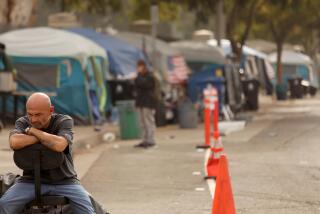BOYLE HEIGHTS : Housing for Disabled Homeless to Open
- Share via
A newly renovated house with bright colors and helpful features, including a long hallway that will be turned into an art gallery, will become home to eight disabled homeless people later this month.
When it opens Oct. 27, the house at 3551 E. 4th St. will be the only shelter for the homeless disabled on the Eastside, according to members of Community Rehabilitation Services Inc., a 16-year-old nonprofit organization at Centro Maravilla that helps the disabled become more independent.
“It’s taken us about three years to get here,” Al Rivera, board president for CRS, said as he stood in the back room that will be used for classes. “It started with an idea, and then someone told us there was money out there for it.”
The idea was to provide accessible, low-cost housing and classes in job skills, financial management and self-defense to help residents become more independent, said Patricia Torres, CRS support services program director.
Yolanda Marquez, 45, will move into the house in about a month, which she said will relieve the pressure of having to live with friends. Marquez is epileptic and has diabetes and hopes to find a job after moving into her new home.
“It’s really pretty and quiet. It’s beautiful,” she said. “I live with a friend now and there’s a lot of problems associated with that and tension. It’s very difficult.”
Marquez volunteers at Unification of Disabled Latin Americans, a group in the Wilshire area that finds services and homes for the disabled. One of the most important things for the disabled is a fully accessible home, said the group’s founder, Ruben Hernandez.
“Housing for disabled individuals is one of the most important tools of rehabilitation,” Hernandez said. “With accessible housing, they can attain their goals, such as school, finding activities and work. This housing is a gift.”
The four-bedroom, two-bath home is a “transitional living facility” designed to help residents learn to live on their own after a stay of no more than two years, she said.
Two back doors are at ground level, and a curving ramp will be built in front to accommodate wheelchairs. Both bathrooms have showers at floor level and are wide enough for people in wheelchairs to roll right in. Kitchen cabinets feature wide handles to make it easier for people with hand mobility problems to open them.
The organization looked in several neighborhoods for a shelter location, but some residents were opposed, fearing drug and alcohol addicts would be brought in for treatment. The owner of the house they settled on was willing to sell the property to house the homeless disabled, and neighbors soon came around to the idea, Rivera said.
The Eastside has an estimated 150,000 disabled adults, and the group expected to be flooded with applications after homeless shelters and agencies that help the disabled were told of the new home. But, so far, few people have applied, and only three have been accepted to live there.
It appears the targeted population is more difficult to contact than had been anticipated. “But we’ll find them,” Torres said. “We know they’re out there.”
The property was purchased for $215,000 and renovated for an additional $230,000, Rivera said. Grants and loans were provided by the city’s Community Redevelopment Agency, the federal Department of Housing and Urban Development, and the California Community Foundation.
Community Rehabilitation Services, which serves 6,000 people a year, is hoping to expand with offices in the Pasadena/Altadena area and near the City of Commerce. It also hopes to build another transitional home for the disabled.
“Everyone’s been real supportive because there is such a need,” Rivera said.
More to Read
Sign up for Essential California
The most important California stories and recommendations in your inbox every morning.
You may occasionally receive promotional content from the Los Angeles Times.






